How to Clean Up Your Email List and Test Email Address Deliverability
The Ultimate Guide
Looking for actionable ways to improve your email marketing performance?
Check out our complete guide to testing email address deliverability for superior inbox visibility and campaign revenue.

As an email marketer, are you struggling with these?
- High email bounce ratesⓘThe percentage of emails that are undelivered vs. delivered to the intended recipient.
- Missing emails
- Customer feedback that says your emails aren’t being delivered
- Poor email campaign performance
Email marketing is an essential part of every business and marketer’s toolkit. However, your power to earn revenue through email marketing hinges on your email address deliverability.
Failure to clean your email list may be the number one culprit.
To help you overcome these challenges, check out our guide, which covers essential topics, including:
- What is email address deliverability?
- How a dirty email list impacts your email deliverabilityⓘA sender’s ability to reach the recipient’s inbox with their outgoing emails. It may also describe the ratio of emails delivered to the inbox vs. those sent to spam or blocked by the receiving server.
- How to test email address deliverability
- How to clean up your email list for better deliverability
- The best practices for email list management
What is email address deliverability?
Email address deliverability is the ability to send emails to a subscriber or customer’s inbox. Note that the term is often used interchangeably with email deliverability.
Just because an email is described as “sent,” it doesn’t mean that it was sent to the inbox. A variety of factors can influence where the email message lands, including the Inbox, the Promotions folder, or the Spam folder.
The email can also bounce back to you.
For email marketers, anything but the inbox is less than ideal. According to our Email Statistics Report, 25% of readers never check their Promotions tab. Many check their Spam folder, but only a few times per year (27%). Others never check it (15%).
Learn more about your subscribers’ email reading habits in our Email Statistics Report!
So, what causes poor email address deliverability?
Email address deliverability comes down to how well your business follows email marketing best practices.
Here are some of the most common culprits for poor email address deliverability.
Poor email list hygieneⓘThe act of or ability to maintain an email list or database consisting of valid and active email addresses.
If your email address deliverability is poor, checking your email database is a great place to start.
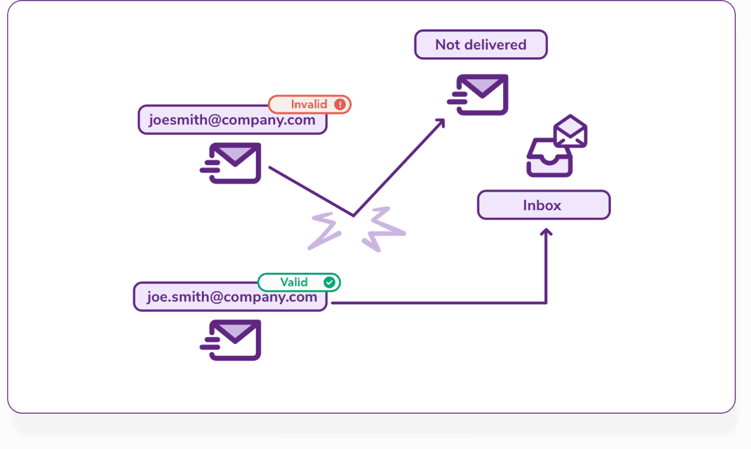
The email addresses on your list can be a direct cause of poor deliverability. The reason for this is that not all of your email contacts are valid (more on that later in this guide).
All email marketers must clean up their email lists regularly to detect and delete invalid email addresses. Any emails sent to those contacts will result in a bounce back.
High email bounce rates
As described above, invalid email addresses lead to hard bouncesⓘThe inability to deliver an email message that’s caused by one or more permanent factors, such as an invalid email address.. However, it’s not the only reason an email can bounce. In fact, there are two types of bounces:
- Soft bounceⓘThe inability to deliver an email message that’s caused by temporary factors, such as a full mailbox or greylisting measures. - Caused by a temporary error (e.g., full mailbox, an offline mail server, greylisting)
- Hard bounce - Caused by a permanent error (e.g., invalid email address, invalid email domain)
Both bounce types can raise your email domain’s bounce rate. However, hard bounces are more problematic as they generally indicate poor email marketing habits - like not cleaning up your email list.
High spam complaint rate
Businesses should only email those that subscribed to their content. Sending a cold email comes with the risk of a spam complaint.
Other behaviors that can rack up spam complaints include sending irrelevant content or too many emails in succession.
Only email contacts that have subscribed to your newsletter. And be mindful not to abuse goodwill by going off-topic or being overbearing with your communications.
Email authenticationⓘOne or more techniques or policies created to help internet service providers determine the identity of an email sender as legitimate. Examples of email authentication include SPF, DKIM, DMARC, and BIMI.
Though the best email marketers know the importance of email authentication, Google and Yahoo have made it a requirement.
As of February 2024, all businesses and mass email senders must authenticate their emails with SPF, DKIM, and DMARC.
In short, these are all methods to authenticate and verify that the email sender is legitimate. Without email authentication, your business (and your subscribers) are vulnerable to phishing, spoofing, and ransomware attacks.
Need help navigating DMARC and email authentication? Check out ZeroBounce’s DMARC MonitorⓘA ZeroBounce service that helps users set up and configure DMARC, also known as Domain-Based Messaging, Authentication, and Conformance, which monitors outgoing emails and assists with email security. Users can actively monitor all outgoing emails sent from their listed domain.. Learn how to set up yours and track every email sent with ease.
Email server configuration
Have you checked the box for all of the above email marketing practices and are still seeing emails bounce/go missing?
A variety of technical factors can impact how your emails are sent and where they end up. These can include port configuration, DNS records, authentication alignment, and more.
To determine if an email server error is affecting your email address deliverability, it’s recommended to test your server immediately.
Diagnose email address deliverability issues fast.
Sign up today and get a free email server testⓘA ZeroBounce service that analyzes an email server’s configuration by performing 100+ checks regarding header information, RFC documents, DNS records, email ports, and email authentication. with 200+ checks.
Email content quality
Finally, the content of the email itself can influence where your email lands.
This applies to the entire email - header, body, and footer. As general rules, be sure that:
- The header has the correct sender information
- The body message is relevant and free of “spammy” keywords or phrases (this can trigger Spam filters)
- Your footer contains valuable, relevant business information (business name and identification details, contact information, etc.)
- The email contains a one-click unsubscribe link
Failure to adhere to these is a red flag that your content might be spammy or risky. In the best-case scenario, your emails might get caught by Spam filters, which lowers your email address deliverability.
Unsure which keywords or phrases are “spammy”?
Check out this extensive Spam Trigger Word guide, which includes more than 100 common terms!
All of these contribute to your business’s sender reputation (also called sender scoreⓘOften used interchangeably with Sender Reputation. It is a score used by internet service providers to communicate your reputation with others based on your historical email-sending habits and behaviors.).
You see, internet service providers (ISPs) need a way to identify untrustworthy mass email senders quickly. Think of how many obvious spam, phishing, or ransomware emails you’ve received to either your personal or professional email accounts. Your inbox can be a risky place when it comes to your personal information.
As a result - every sender has a sender reputation. Think of it as a credit score for emails. Those with solid sender scores have low bounce rates and minimal spam complaints while only sending emails to valid contacts who have opted-in to their content.
Good
Versus
Bad
Sender Reputation


Conversely - not doing the same will earn your business email domain a poor sender score. When your sender score is low, ISPs are less sure about the safety of your emails. As a result, they’re commonly sent to Spam. You may also see more email bounces as a result.
Do you want a master list of everything that affects your email deliverability?
Check out our definitive Email Deliverability Guide and become an email marketing master.
How a dirty email list impacts your email address deliverability
Poor email list hygiene remains one of the biggest causes of poor email deliverability.
You shouldn’t assume that any or all of your email addresses are valid, regardless of where they came from. But before we get ahead of ourselves, let’s look at what we mean by “valid.”
- Valid email address - Contains the appropriate syntax, is a verified email address that exists on the provided domain and is in use
- Invalid email address - Doesn’t use valid syntax or doesn’t exist with the domain or provider
You should validate your email list regularly and delete any detected invalid email addresses. Because these contacts either don’t use a valid email format, or simply don’t exist, emailing them will result in bounces.
And as we learned earlier, high bounce rates are detrimental to your email address deliverability. Exceedingly high or consistently high bounce rates can even cause your email provider to suspend your business account.
But valid and invalid email addresses aren’t the only types to look out for. As of now, ZeroBounce detects more than 30 email address types that can be categorized into relevant statuses and sub-statuses.
Here are some notable ones that can impact your email address deliverability:
Abuse emails- If you were to check these emails with a standard email verifier, they’d show as valid. However, these users ‘abuse’ the spam report function. Thus, they have the potential to increase your Spam Complaint Rate.
Disposable emailsⓘA temporary email address that users can create using a temporary email website or creation tool. You can use a disposable email address for a brief period before it expires and becomes invalid. - At first, a disposable email address is a valid address. However, after a short period (usually 15 minutes), they stop working and become invalid. Even if you have an email verifier, unless it can detect disposable domains, it’s easy to rack up email bounces due to these email addresses.
Spam Traps - Emailing a spam trap won’t result in a bounce. However, they will hurt your sender reputation. A spam trap is either a new or repurposed address used to catch mass senders who aren’t cleaning their lists. A spam trap can potentially put your business on an email blacklist/blocklist.
Toxic Domains - A toxic email domain is known to be guilty of spam and other malicious activities. Avoid interacting with toxic domains to stop preventable email address deliverability issues.
Catch-alls or Role-based - Catch-all and role-based email addresses are impossible to verify successfully. They’re designed to capture incoming messages sent to otherwise invalid addresses on their domain. However, catch-alls commonly go unsupervised due to the amount of spam they receive. Emailing one may result in a bounce or zero engagement.
The email addresses that exist on your email list have a direct and significant impact on your email deliverability.
What’s more - even clean email lists will decay in time. According to a study of all email validationsⓘA process that determines if an email address uses valid syntax, exists on a given domain, and is configured to receive incoming email messages we performed, nearly 25% of your list suffers email decay annually.
In other words, even if you’ve deleted all of the invalid, risky email addresses from your list, you will still suffer email address deliverability issues if you don’t clean up your email list regularly.
Do I really need to care about cleaning my list?
If the verifiable evidence of how poor email list hygiene impacts deliverability doesn’t convince you, consider these points.
You can’t increase email marketing revenue if your emails aren’t delivered
Think of email list cleanup as the bare minimum necessity for successful email marketing. If a salesperson makes phone calls all day to invalid numbers, how can they close deals?
Likewise, you must verify that your email leads actually exist before you can consider crafting engaging email content. It doesn’t matter if you have the best designer and email copywriters available; your emails won’t perform if customers don’t see the message.
People don’t often check spam
If you have low email address deliverability as a result of poor email list hygiene, much of your content may go to the Spam folder.
As discussed above, when mentioning our Email Statistics Report, anywhere from 15% - 27% of your contacts may never see your email in Spam. And, considering that average open rates linger around 20%, poor inbox visibility isn’t doing your business any favors.
Clean up your email list to give yourself the best opportunity for email marketing success.
Content in the Spam folder is less trustworthy
It’s called the Spam folder for a reason. Messages that arrive there are usually associated with scammers, thieves, malware spreaders, and more.
That isn’t the company a legitimate business should keep.
First impressions are everything. So, even if your contacts see your email when checking the Spam folder, there’s a chance that they could come to associate your brand with spammy content.
How to test email address deliverability with ZeroBounce
To test email address deliverability, there are a couple of routes you can take. Below, we’ll go through the tools you can use to get started today.
Use the inbox placement tester
The most accurate way to determine your email address deliverability is to send an email to different email providers.
You could set up different accounts using the providers you wish to test. Then, send an email from your business email domain to those addresses. Determine whether your emails land in the Inbox folder or Spam to gain an understanding of your email address deliverability.
However, doing this comes with the unnecessary risk of additional email bounces and poor email performance.
Instead, you can use ZeroBounce’s Inbox Placement Tester tool, which is explicitly designed to test the deliverability of your emails.
Here’s how it works:
- Create your email as usual. You can use your typical email provider/builder like Mailchimp, AWeber, Constant Contact, etc. Providing a real email will help us accurately assess your email address deliverability.
- Create a new Inbox Placement TestⓘA process that allows users to analyze how an email performs with various email service providers before sending the campaign to a real audience. The test identifies errors with the header, body, and footer to help users remedy problems that prevent them from reaching the inbox. using a free ZeroBounce account. To help you try it out, we give all users a new monthly test for free.
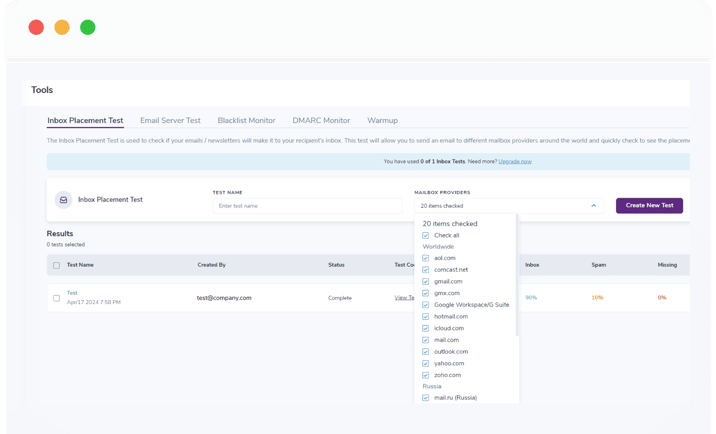
When setting up your test, you can select more than 20 well-known international email service providers. We have testing email addresses set up on each to test email address deliverability in detail.
The list of providers includes AOL, Comcast, Gmail, G-Suite, Hotmail, Yahoo, Outlook, and more.
- We’ll give you the testing addresses along with a subject line to match your created test. Then, simply send and wait for your results.
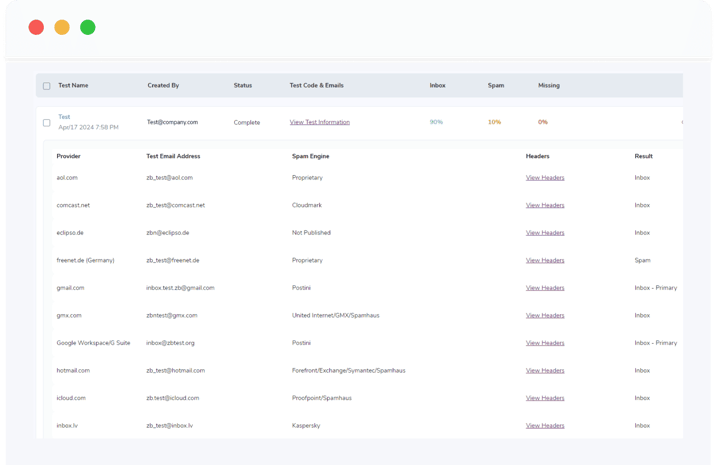
When your email address deliverability test is completed, you’ll get a detailed breakdown of how many emails went to the Inbox, the Spam folder, or went missing. We also list the Spam Engine used by the email provider for each address so you can diagnose potential deliverability issues caused by unique spam filters.
You’ll also get a comprehensive report of the header information received by each ESP. This information will assist with diagnosing header errors, which can impact the email’s deliverability.
In addition to the detailed feedback you’ll receive, using this to test email address deliverability is risk-free and allows you to scrutinize your emails before sending a live campaign to your audience.
Track email address deliverability with email WarmupⓘA service that helps email senders improve their mailing domain and IP reputation by sending genuine email content to predetermined email addresses. Users will gradually increase the volume of emails sent while receiving positive engagement through an automated process.
Warming up emails is a common practice for businesses that are establishing a new email domain.
Remember how we described your sender/domain reputation as a credit score? A lack of history can also negatively impact your email address deliverability. Therefore, email Warmup toolsⓘA service that helps senders build, improve, or maintain their email domain reputation and improve email deliverability by sending real email messages that deliver positive engagement, such as opens, clicks, and favorites. are commonly used to gradually build that positive reputation through automated engagement.
However, warmup can also be used to repair negative domain reputations or maintain existing ones. It’s a practical, easy-to-use solution for any business that wants to actively improve their email address deliverability.
Here’s how it works:
- You’ll need to create a ZeroBounce account and subscribe to the Email Deliverability ToolkitⓘZeroBounce’s package of email deliverability tools and services, which includes the following: Warmup, DMARC Monitor, Email Finder, Blacklist Monitor, inbox placement testing, and email server testing..
Not only will you get Warmup, but you’ll get access to other essentials like blacklist monitoring, DMARC monitoring for authentication and email tracking, email server testing, Email FinderⓘA tool that allows users to look up an email address by using either a name, an email domain, or a combination of both data points., and additional inbox placement tests.
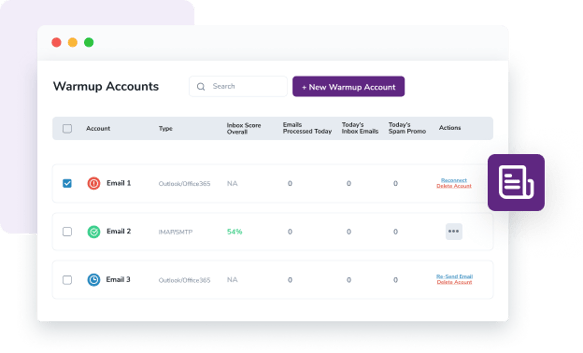
- Set up your business’s email domain and authenticate it with the Warmup tool.
- After set up is done, ZeroBounce will manage your Warmup based on your preferences. We’ll automatically send emails from your domain to a list of trusted seed email addresses, and generate the positive engagement you need to improve your domain’s reputation.
As you send emails over time, or allow us to send emails for you using the ZeroBounce-managed method, your Warmup dashboard will populate with your Inbox Placement Score. This score is a percentage that breaks down your lifetime email address deliverability by comparing how many emails go to the inbox vs. how many go to Spam or Promotions.
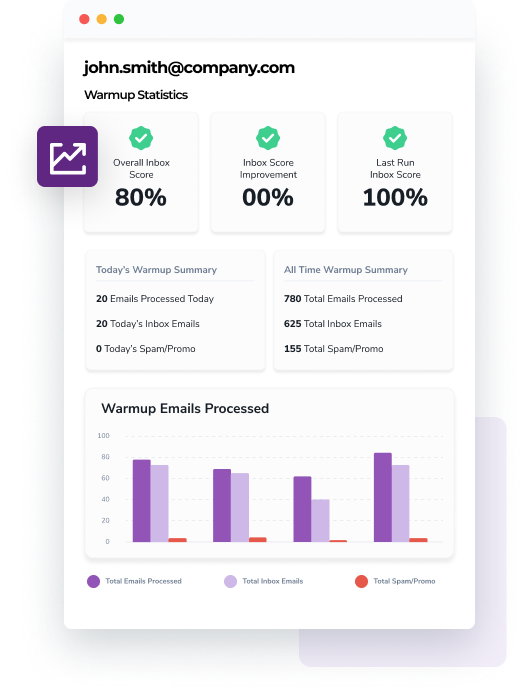
A key differentiator between Warmup and inbox placement testing is that Warmup actively improves or repairs your domain reputation. Whenever you send those emails, we set up automated actions to provide your emails with positive engagement by carefully simulating realistic behaviors that feel authentic to email service providers. Those actions include opens, favoriting/starring, clicking, etc.
Not only will you have a linear graph that tells the story of your email address deliverability, but you can also adjust your tactics as needed. If you identify a deliverability issue, you can set Warmup to Repair. If everything looks good, you can choose to maintain your good reputation with steady sending.
How to clean up your email list for better deliverability
Before assuming there’s a more critical issue with your email address deliverability, ask yourself: Have I cleaned up my email list?
Many email deliverability issues start with your email database. Even if your email content is sublime and your server is configured correctly, your email will always bounce if the target address is invalid.
Thankfully, verifying your email list is an easy task. Here’s how to clean up your email list with ZeroBounce.
Upload your email list using your preferred method.
ZeroBounce provides a host of options – including direct file upload, cloud connection, the API, or through one of the supported integrations.
- For file uploads: Export your email list as a CSV, TXT, XLS, or XLSX file. Then, upload the file using your dashboard.
- For cloud support: Use Dropbox, Google Drive, Microsoft OneDrive, Amazon S3, or SFTP/FTP to retrieve your email list file.
- Finally - Check out the complete list of integrations. You may be able to import your list directly by connecting your account if your CRM or ESP is supported.
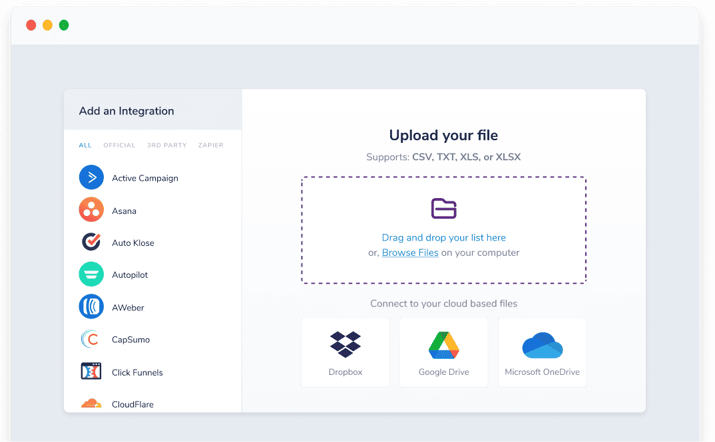
As an additional option - you can download the ZeroBounce iOS app to upload with your phone or tablet.
The next step is optional.
If your email list contains a high volume of Yahoo, AOL, or Verizon email addresses, you’ll receive a warning notification.
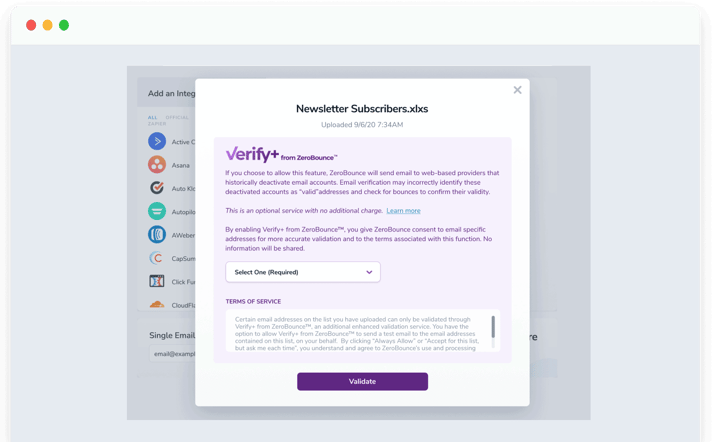
For context - Yahoo presented a problem for the email marketing industry by indefinitely disabling real email accounts. They’ve been stuck in this status since roughly 2018. This presents a problem as there’s no great way to determine if a mailbox is disabled.
Thankfully - ZeroBounce provides the email marketing industry with the first solution via its Verify+ from ZeroBounce service. It’s recommended that you opt into this service to identify disabled email accounts on your list accurately.
Next - just sit back and wait. ZeroBounce will thoroughly validate the email addresses on your list with 99.6% accuracy - guaranteed.
Whenever the email validation process is complete, you’ll receive an email notification. This message will include an encryption key, which allows only you to access your results.
To clean up your email list, look through the results folder for a subfolder called “valid.” This is a modified version of your email list that contains only “valid” email addresses. Addresses classified as “invalid,” “spam traps,” “abuse,” etc., are relegated to their respective folders.
By importing your new, valid email list back to your ESP or CRM, you can be confident that your emails will reach real contacts. Your results will also include a breakdown report showing what your original email list contained to help you understand its health.
You can automatically clean up your email list with an API
Regular email list cleaningⓘThe process of removing invalid and high-risk emails, such as spam traps or disposable emails, from an email list. Email list cleaning can be performed after gathering data via email validation. is a requirement regardless of your current email address deliverability or sender reputation. It’s a preventative measure that helps you avoid bounces and stay on top of expected email list decay.
One of the best ways to do this is to take advantage of real-time email verification via an API. An API (application programming interface) allows your email validation tool to interact directly with your platform of choice.
Here are some practical ways to implement an email validation API to keep your email list clean.
Add it to your website forms - By adding an API to your newsletter signups, landing pages, etc., the email validator will automatically detect invalid or risky emails. You can prevent bad data from entering your database automatically.
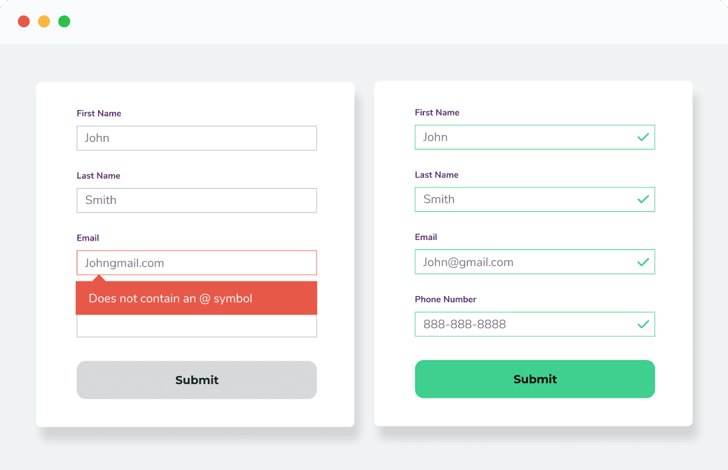
- Add it to your e-commerce checkout - Valid emails are essential for transactions and account registration. Help your customers ensure that they enter a valid contact address by adding the API to your checkout process.
- Monitor new contacts added to your CRM - You can configure the API to review new contacts when added to your CRM automatically.
In addition to using the raw API, many of ZeroBounce’s integrations allow you to leverage features like Contact Monitoring and Scheduling to clean your list regularly.
Best practices for email list management
Now that you’re armed with the knowledge and resources you need to clean up your email lists, it’s time to think about best practices moving forward.
Consider adding these practices to your typical workflow to give yourself an edge in preventing email address deliverability issues.
Clean up your email list once per quarter
To emphasize its importance, clean up your email list frequently.
At a minimum, it’s recommended to upload your entire database for email validation at least every three months. Doing this will help you combat email list decay and keep your bounce rate low.
However, you should clean your lists more frequently if you receive an influx of new leads. For example, if you receive a lead list from a convention, conference, or public event, clean those email addresses before you add them to your clean database.
Use real-time email validation to block fake signups
Automatically verify new email addresses to make list cleanup even more efficient.
By adding a real-time email validation API to your forms, you receive two primary benefits. First, you’ll automatically detect and block fake, disposable, or bot-generated emails that lead to bounces and poor campaign performance.
Second, the API will alert your real visitors to typos or misspellings when they enter their information. Help them ensure that their registration or signup data is accurate to avoid missed connections with valuable leads.
Use double opt-ins to verify subscribers
Another way to verify new email signups is to employ a double opt-in subscription process.
Whenever a visitor signs up for an account or for your newsletter, send an automated email to the provided address. The visitor must confirm their subscription by clicking on a link in the email.
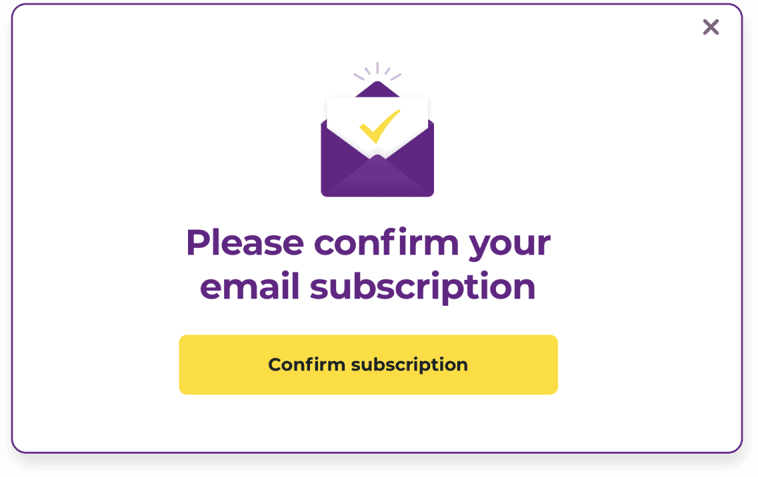
This is a useful way to verify a mailbox’s existence and allow visitors to confirm their intent to receive future emails from your company.
Remove inactive subscribers from your list
Many email marketers are hesitant to shrink the size of their email list. But, those subscribers that don’t engage with your emails aren’t helping your campaign performance.
Don’t think of it as losing out. If the subscriber isn’t interested in your product or service, move on to those that will engage.
Eliminating unengaged, inactive subscribers will improve campaign numbers as you refine your message targeting. Strong email performance will also benefit your email address deliverability.
Score your email leads
Not all leads are created equal. By scoring your email addresses, you gain deeper insight into your subscribers.
ZeroBounce’s Email ScoringⓘA ZeroBounce service that uses AI and proprietary technology to grade an email contact based on their likelihood to interact with an email and convert (most commonly used for catch-all email addresses). service measures your email leads on a scale of 1 to 10. A score of one illustrates that the email address is inactive and possibly abandoned. On the other end, a high score of ten represents a highly active email contact that engages with emails by opening, forwarding, and clicking. They may also unsubscribe from emails as needed.

It’s recommended that new email addresses be scored after they are validated. This will help you segment those leads by quality and set you up for predictable, quality email campaign performance.
Honor your unsubscribe requests quickly
If a contact tells you that they’re no longer interested, respect it.
There’s little sense in trying to persuade someone to buy your product that isn’t in the market - or interested in you.
Not only is this required by CAN-SPAM, but spamming uninterested contacts will only lead to email address deliverability issues. Expect spam complaints and issues with your email provider.
Respect your audience and treat their inbox as a sacred space. Earning your place there is a privilege.
Segment your email lists to narrow down your audience
A key component of revenue-rich email marketing is email list segmentation.
In a perfect scenario, we’d have the ability to talk to every subscriber and determine the best way to speak with them. Meanwhile, we can curate personalized messaging by breaking our email audience into groups where the contacts within feature shared attributes.
Here are some actionable examples you can use to segment your lists today:
- New customer onboarding - Welcome your new subscribers or customers. Feature helpful content or welcome offers that encourage them to interact further with your website.
- Target customers buying specific products or services - This list works well if you sell solutions for different pain points. Create email content that speaks to their purchase history or interests. You can also cross or upsell related services.
- Re-engage lapsed customers - It’s cheaper to seek out repeat purchases than to find new customers. There’s a lot of noise online and our inboxes are always full. Give lapsed customers a gentle reminder that you’re still there for them.
- Cart abandonment - Some of your leads almost made it to the finish line, but stopped short. But all hope is not lost. Reach out to let them know what they left behind. You can also include a limited-time promotion to close the deal.
Additionally, you can always set up your forms or emails to look for subscriber preferences. Instead of asking permission to send all emails, make it easy for visitors to select what type of content they’d like to receive.
Take all the information your audience is willing to give and use it to craft the perfect email campaigns for your business.
Test email address deliverability with ZeroBounce
Your email deliverability is essential for producing email marketing revenue.
Be sure to keep this guide on how to clean up your email list and test deliverability handy throughout your email marketing ventures. There are many factors that can cause poor deliverability, and it’s worth knowing how to test it.
You can test email address deliverability right now by creating your free account with ZeroBounce.
Contents
- to find more details about links
- What is email address deliverability? to find more details about links
- How a dirty email list impacts your email deliverabilityⓘA sender’s ability to reach the recipient’s inbox with their outgoing emails. It may also describe the ratio of emails delivered to the inbox vs. those sent to spam or blocked by the receiving server. to find more details about links
- How to test email address deliverability to find more details about links
- How to clean up your email list for better deliverability to find more details about links
- The best practices for email list management to find more details about links
Free ZeroBounce Accounts Include
100 credits
To clean up your email list or score catch-alls
1 Inbox placement test
For testing deliverability
1 Email server test
Diagnose 200+ issues that can impact deliverability
1 Blacklist Monitor
Get alerts if your email domain is blacklisted
10 Email Finder queries
A reliable way to find new email addresses
All benefits are yours free - every month
Test your email address deliverability
Questions?
If you have questions about testing email address deliverability or how to clean up your email list, we’re here to help.
Just click the chat bubble in the bottom-right corner, and one of our email geeks will be there to assist you 24/7!
Frequently asked questions about email deliverability
You can test email address deliverability by sending an email message from the address/domain to multiple mail providers. If all or most of your emails reach the inbox, your email deliverability is in good shape. Conversely, if your emails bounce or go to the Spam folder, there are deliverability issues you need to resolve.
It’s recommended to use a tool like an inbox placement tester to test your email address deliverability with no risk to your reputation. You’ll be provided with test emails for 20+ email domains and be able to track the results directly from your ZeroBounce dashboard.
You can clean up your email list by uploading it to an email validation tool. The email validator detects valid, invalid, and risky email address types, including spam traps and disposable addresses. Then, take your new email list that contains only valid email addresses and reupload it to your email service provider or CRM for future campaigns.
It’s recommended that you clean your email list at least once per quarter. If your list growth is high or if you receive a sudden influx of new email addresses, consider cleaning your list more frequently. Also, an email list that’s been cleaned before isn’t necessarily still clean. Email lists decay at approximately 25% annually, which may indicate invalid or expired email addresses on your list.
A variety of important factors influence your email address deliverability including the following: email list hygiene, domain/sender reputation, email authentication, email bounce rates, spam complaints, email server issues, and campaign performance.
For example, possessing a dirty email list, not authenticating your emails, and having a high bounce rate create long-term poor email deliverability. To improve your email deliverability, you need to regularly clean up your email list, verify your messages, and keep a low bounce rate.